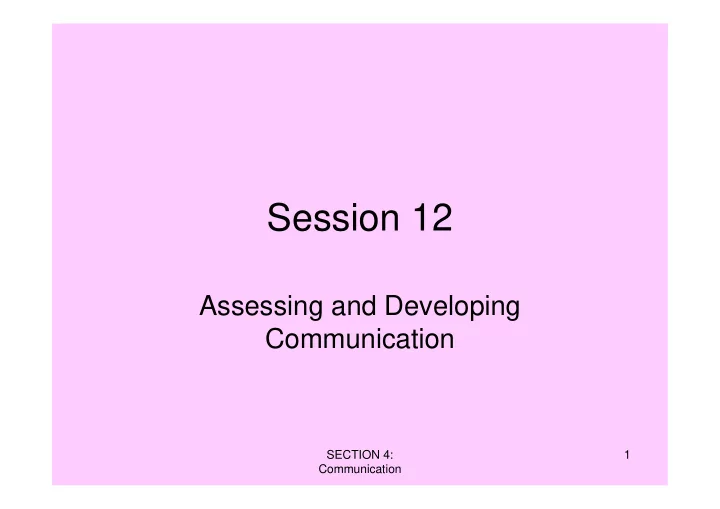

Session 12 Assessing and Developing Communication SECTION 4: 1 Communication
Communication assessment • of communication during everyday events • to see which is the most effective communication method • of verbal communication SECTION 4: 2 Communication
Consistency • It is essential that all staff understand the communication assessments. • You need to know what to do to support understanding and the ability to make choices. SECTION 4: 3 Communication
Sarah How Sarah understands an activity is How she shows she wants or does not available want to join in. SWIMMING If Sarah wants to swim, she will smile, Say “Sarah do you want to swim.” and vocalise. She sometimes puts her Show her the swimsuit and towels and things in the bag. A couple of staff the swimming cap. Put them beside the members say they have heard her say stripped bag. a word like ‘wim’. If she is not interested, she will walk away. GOING OUT IN THE BUS If Sarah wants to go, she will explore Say “Sarah, do you want to go in the the key ring. She may put the mirror in bus?” Show Sarah the keys with the her mouth. Then she will get up and mirror in the key ring, hold your hand take your hand. out to and beckon “come on”. If Sarah does not want to go she may explore the key ring briefly, but she does not stand up. SECTION 4: 4 Communication
Sarah It can be seen that Sarah needs a mixture of clear short sentences, gesture and objects of reference to understand situations and express her needs. It is important staff communicate consistently so that Sarah has a chance to anticipate what is happening and participate as fully as possible. SECTION 4: 5 Communication
One word level Understanding Sentences such as these can be very confusing for someone who only understands the single word ‘sweets’ • Yes, we are going to buy sweets. • You haven’t any money for sweets and I’m afraid the shop is shut. • After you’ve had your hair cut, we will get some sweets. Keep your information short and to the point and immediate. SECTION 4: 6 Communication
Social interaction • Knowledge of early social interaction for typical infants has influenced work with adults with SLD/ PMLD • Intensive Interaction is based on assessing and developing the processes involved in early interaction which are characterised by pleasure, fun, sensitivity and intuitive responding. • Other interactive approaches build on activities that motivate adults and enable them to have fun SECTION 4: 7 Communication
Communication Passports Passports are a positive way of supporting people with sensory and communication disabilities who cannot speak for themselves by collecting together important information about them and making this accessible to others with whom they may interact. SECTION 4: 8 Communication
Introducing Passports • Can you think of a service user who would benefit from a communication passport? • What sort of things might usefully be included? • Who should contribute to the passport? • Who needs to see the passport? SECTION 4: 9 Communication
Recommend
More recommend